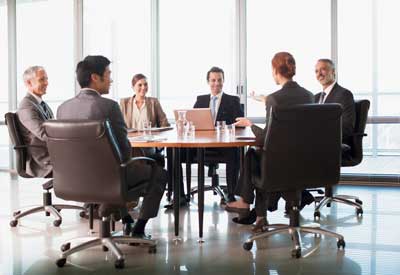Wednesday, November 8, 2023
Choosing conference room furniture can be a difficult but important decision. Whatever you buy may stick around for years, and you don’t want something that causes discomfort or fails to accommodate frequently-used technology.
Before you make any decisions, consider everything you’ll need from your meeting spaces. The number of people you need to seat, the equipment you want to use, the ambiance you want to create, and even whether or not people will be eating snacks may affect your choice.
Take Measurements
The first thing you should do before choosing office furniture is take measurements. You don’t want to buy a table only to find that there’s insufficient space for adequately sized conference room chairs.
Determine How Much Space You Need for People

People are the main factor in determining the size of your table and any additional furniture. Make sure you know how many people will need to be in the meeting room, and allot plenty of space at the table for all of them. Many office conference rooms are used for presentations, sales, or other important conversations with both employees and clients. Be sure you select furniture that accommodates for your employees and any guests you will have.
Here are a few general guidelines:
- For 4-6 people in a 15’ x 13’ conference room, you may only need a 60” x 40” table to comfortably accommodate everyone.
- If you’re trying to seat two dozen people in a 34’ x 14’ room, you’ll need something closer to a 288” x 58” table.
- For easy movement, add 4-5’ of space between the wall and the table, 2.5’ at the table edge for each chair, and 2.5’ for standing at the head of the table and presenting. If you’re pressed for space and willing to walk sideways, you may be able to get by with 18” between the back of each pushed-in chair and the wall.
Consider the Equipment You’ll Use
Conference rooms don’t only house people, they also hold projection screens, AV carts, storage furniture, and similar space-consuming equipment. To get an idea of how much space you need for these objects, measure their dimensions and consider where you’ll place them in the room. Some equipment may need to be near power sources or phone jacks.
If you’re using AV or teleconferencing equipment, consider a conference table with a wire management trough or a power/data access port.
How you Plan to Work with Your Conference Room Table
Do you intend to only use the conference room for large meetings, or will people sometimes break into smaller groups? If it’s the latter, you may need a modular table that can separate into smaller chunks and move around.
AV and teleconferencing equipment may require special consideration. AV carts often require more aisle space than you would allot for people walking, so make sure you’re leaving extra space to move it around.
It may also be helpful to find a conference table with a wire management trough or a power/data access port. If you’ll have frequent visual presentations or videoconferences, make sure natural and overhead lighting doesn’t interfere when you set up the equipment where you were planning.
Feeling and Functionality
The furniture design and shape will be a major factor in creating the right mood for your team. Different conference table shapes may be more useful in some situations. Here are a few common shapes:
- Rectangular tables are classic and unobtrusive. These tables are generally suitable for both meetings and training.
- Round conference tables feel more inclusive and relaxed. Additionally, they can create the illusion of more space when you have a small conference room.
- Boat-shaped conference tables, which have convex sides and slightly tapered ends, create a stylish look. You might consider a boat-shaped table if you want to impress clients.
- Oval or racetrack conference tables are pleasing to the eye and less “boxy”-feeling than a rectangular conference table.
- Octagonal tables are a striking option. They can make a significant visual impact in larger conference rooms or be a compact option in smaller spaces.
Materials are also an important aspect of both creating an ambiance and ensuring optimal function. If snacks and beverages are part of your meetings, you’ll want a table with a thick, protective finish.
- Genuine wood conference tables are generally considered to be the most durable option. It's also more expensive because manufacturers don't make it from recycled or processed materials.
- Engineered woods are a less expensive option, but may be less durable. These materials include particleboard and medium-density fiberboard (MDF), which is stronger than particle board and more affordable than solid wood.
- Wood veneers are thin slices of real wood that can be applied to any flat surface, including an engineered wood table. A veneer can creates the look and feel of real wood at a lower cost and may be anywhere from 1/100 to ¼ inch thick.
- Laminate conference tables are made from various combinations of wood, plastic, and other materials. Laminates are generally strong, durable, and easy to care for.
Everett Office Furniture offers a wide range and used and new office furniture to meet your needs. Check out our products today.